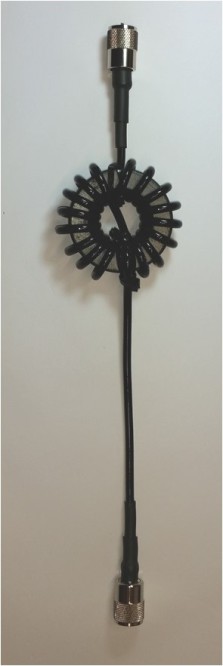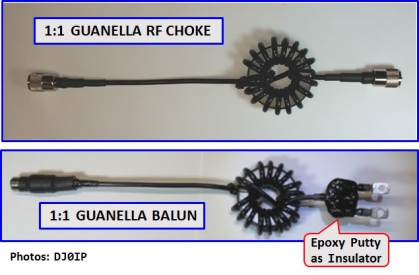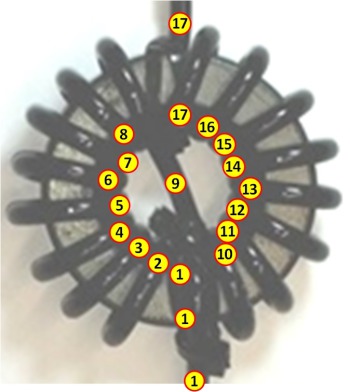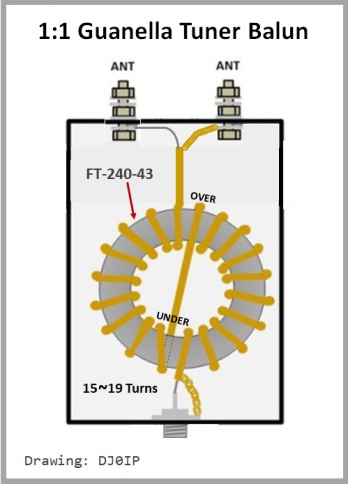1:1 Guanella Choke (D2)
By popular demand, I have now given this choke its own dedicated page.
The choke described below is exactly the same as "D2" shown on the previous page.
For more information, also read about "D1" on that page.
This is my 'go to' RF Choke that I use for most applications.
An RF Choke's ability to block (impede) Common Mode Current may be measured either in Common Mode Impedance (CMI) or in dB of blocking. Regardless how we measure, its ability to do this is determined by:
1) The type of Toroid we use (i.e. specific ferrite mix, such as #31, #43, #52, #61, etc.).
- This is both frequency and application dependant. Different antenna types exhibit different Common Mode Current characteristics; some have more, some have less. Therefore some require more choking, some require less.
2) The number of turns of coax, bifilar, or twisted pair wires that we wind onto the core.
- This is again frequency and application dependant. Different antenna types exhibit different Common Mode Current characteristics; some have more, some have less, etc.
3) The size and number of Toroids that we use. The power handling ability is determined by a combination of the ferrite mix and how much ferrite mass we use.
- Different ferrite mixes have different Curie points with huge differences. A low Curie point means a lower power rating.
- However higher permeability which gives us higher CMI values, usually means lower Curie point.
- It is a double-sided sword!
- Care must be taken to choise the right combination for the application at hand.
- THERE IS NO 'ONE SIZE FITS ALL' SOLUTION!
All of the above must be taken into consideration when designing a choke or balun for a particular application. For some reason, most balun/choke manufacturers don't bother to do this, Instead they offer some "Wonder-Balun" (or Choke) that is a Jack of all Trades, but Master of None!
As a rule of thumb, with #31 or #43 ferrite, I use 1 core per 500w up power.
- 1 Core for up to 500w
- 2 Cores for up to 1000w
- 3 Cores for up to 1500w
In fact since I only run SSB and CW with a maximum power level of 750w (for DL), I only use one core. If I were running RTTY, I would use 2 cores.
For #52* ferrite, I use 1000w per core as a rule of thumb.
For #61** ferrite, I use 1500w per core as a rule of thumb.
- Again these are ratings for SSB and CW, not RTTY. For RTTY add another core.
- * Marginal CMI on 160 and 80m, good on 40m and above.
- ** Not usable for 160 and 80m; marginal CMI on 40m, good on 17m and above.
The picture below shows a choke that I use indoors and for short outdoor tests or excursions. For permanent outdoor installation , you should coat the Toroid with a couple thin layers of liquid electrical tape before winding the coax onto it. (Tip: let it dry before winding - hi).
1:1 Guanella (W1JR) Choke / Balun**
This RF Choke consists of :
- 1.40m (4'7") of special Teflon-like Coax (DXW142), similar to RG-142. (RG-142 is even better)
- with 17 turns "cross-wound" (W1JR)
- onto an Amidon FT-240-43 or FT-240-31 toroid core.*
-
2x PL-259, with gold-plated contacts, and Teflon insulation.
- * for 80 thru 10m, use "-43";
- * for low bands (160/80/40) use "-31".
DXW142 FEP/TPE-U coax cable 50 Ω Specs:
- Inner conductor material : solid copper, tinned
- Inner conductor diameter: 0.98 mm
- Dielectric: FEP, 3.02 mm
- Power handling (estimated) : 4KW @ 10MHz / 2KW @ 30MHz
Its inner conductor is made of solid copper (with better thermal conductivity than the Copperweld steel wire in RG142B/U). By tinning, FEP was used as a dielectric, since only silver plated wires can be extruded with PTFE. FEP nearly reaches the properties of PTFE
According to the chart on G3TXQ's RF Choke web page, this balun (wound on a #43 core) exhibits the following CMI characteristics:
- 160m >4 kOhm
- 80m 8 kOhm
- 40m 4 kOhm
- 30/20/17m 2 kOhm
- 15/12/10m >1 kOhm
For more exact details on core type and number of turns, see the colorful chart on G3TXQ's web site, here: http://www.karinya.net/g3txq/chokes/
** 1:1 Guanella Choke Vs. 1:1 Guanella Balun:
- The Choke has two PL-259 Coax Connectors.
- The Balun has a PL-259 on one end and a pair of terminals on the other end.
Here is a comparison of two of mine:
As can be seen in these two pictures on top, there's not much difference in my choke and my balun. Both use heat-shrink tubing with hot-melt glue on the inside
to weather-proof the PL-259. In this case I added a double-female adapter to the balun and covered it with heat-shrink tubing. You may also do that for the RF Choke.
I have redrawn the Tuner Balun to be more specific on the connections.
BTW: The balun shown here is what I use for a Tuner-Balun - external to my antenna matchbox. I NEVER use the built in balun in any matchbox, for reasons explained elsewhere on my web.
(See WHY: "EXTERNAL" TO THE ANTENNA TUNER?". (Near the bottom of that page.)
COUNTING TURNS
When cross winding, the fold-back (turn 9 here) also counts as one turn.
As can bee seen, I have wound 8 turns on each side, plus the fold-back, totaling 17 turns.
The coax shown here is similar to RG-142. You may use RG-58 for up to a few hundred watts, but you should switch to RG-142 for higher power levels.
Do not use thich coax such as RG-213. You can't get enough turns onto the core.
You should solder one PL-259 onto the coax BEFORE winding. Be sure to solder the braid and use heat-shrink tubing for weather-proofing.
A SIMPLE TUNER BALUN
The drawing on the right shows a simple, but effective Tuner Balun that can be used between an unbalanced Antenna Tuner and Balanced Transmission Line.
If wound with RG-58, it is good for a couple hundred Watts. Use RG-142 coax (Teflon insulated) for higher power.
For up to 500 Wats, one Toroid is enough.
For 1kW, use a stack of 2 Toroids.
For 1.5kW, use a stackof 3 Toroids.
For 40m and above, 15 turns is enough.
For 80m and above, use 17 turns.
For 160m, try to get 19 turns onto the core. If you only manage to get 18 turns, then use it.
If you prefer, you may use Bifilar windings instead of coax, but I strongly recommend using Teflon-insulated wire. In theory this is slightly better, but in practice you won't notice a difference.






























